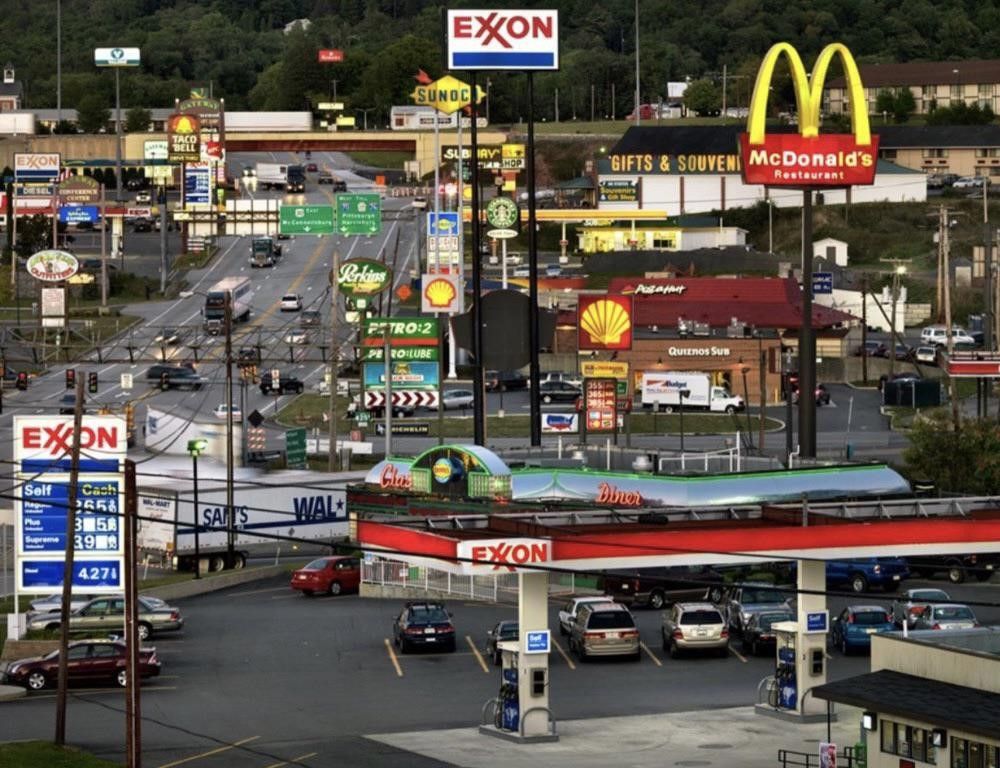Aesthetic Reform
How does pointing to the decline of aesthetics improve them?

Often called the "Town of Motels," the area of Breezewood, Pennsylvania stands as a vivid tableau of the American economy's evolution. At a first glance, the bustling interchange, aglow with neon signs and fluorescent lights, might draw criticism as a hideous embodiment of consumerism. Communities like Reddit routinely criticize the town as being emblematic of "late-stage capitalism". Such critiques only skim the surface of a complex narrative tracing America's transition from its manufacturing roots to a service-oriented economy.
The landscape of Breezewood is not unlike a sculpture, though it is always unfinished. We can view our society, ever on the move, as the artist which carves out the town, its geometry shaped by the demands of the sculptor. The town's primary function as a rest stop belies the intricate economic and social ecosystem that sustains it. This shape, or aesthetic—the blinding lights and strip malls—while often lambasted as blight, are arguably secondary to the town's true essence. We can continue to critique the sculpture as it exists now, and draw conclusions about our society from our current place in history. Or we can analyze how the sculpture's shape has changed over time; the decisions of an artist reveal more about them than their art alone. Prescriptive vs. descriptive.
There's an irony in a city that never sleeps. The phrase is usually associated with metropolitan cities like New York or Las Vegas. Breezewood is no different, people are awake and doing business all hours of the night. While it is a place for rest, it is also tirelessly awake. The very existence of the town hinges on the availability of service workers who ceaselessly cater to those passing through. This, in turn, necessitates a residential community to uphold the 24/7 economy. Breezewood, therefore, is far from being a mere "tourist trap" – it's a living, breathing settlement where life is punctuated by the comings and goings of visitors. Employees who work in the town must carry out their lives nearby, not everyone can have a one night stand with Breezewood. Residents of the town must feel like they're living in an airport.

The critique of Breezewood's aesthetics often misses a larger point: the town is an artifact of American automotive culture, a necessary construct that has evolved to meet the needs of a society that values sovereignty above all. Originally built to improve transportation for our military, as well as vehicles moving goods across the United States, the Interstate Highway System was a decades long project to raise the standards of the nation's infrastructure. Development began in 1916 with the passage of the Federal Aid Road Act, and culminated in the Federal Aid Highway Act of 1956, enacted by President Dwight D. Eisenhower who was inspired by his own journey across the United States as well as Germany's Reichsautobahn system.
It was evident we needed better highways. We needed them for safety, to accommodate more automobiles. We needed them for defense purposes, if that should ever be necessary. And we needed them for the economy. Not just as a public works measure, but for future growth. - General Lucius D. Clay
The service economy that Breezewood epitomizes is not an aberration but a distinct marker in the progression (or regression) of our nation's economic development, where value now lies in the provision of services rather than the manufacturing of goods. Would the town have flourished if we had not developed our highways in order to bolster the infrastructure of the nation at large? We must interrogate ourselves with questions like this to make sure we are not confusing the symptoms for the disease. How many problems have been solved posting photos of Greek statues and historic European buildings to remind us of the past? Just like the engineers of America's highways, we need to reach out into the future to solve the problems we face today. The decline of the West can be seen with the naked eye, any fool can tell you that our nation is being transformed. Are Americans content with pointing to yesterday's standards? Will appeals to a distant and ever-receding past be enough to stop, let alone reverse the decay?
There is room for introspection and improvement. The nation's attitude towards beauty and living standards has changed. America faces an unprecedented debt crisis; it will require forward thinking and discipline to strike a balance between economic necessity and aesthetic appeal. If you suspect culture is drifting off course, you'd be correct to lay the blame at the leaders driving this reshaping of America. Breezewood is not simply an artifact of "late stage capitalism", and it is not a Jackson Pollock piece painted by the invisible hand of markets. It is our home.
